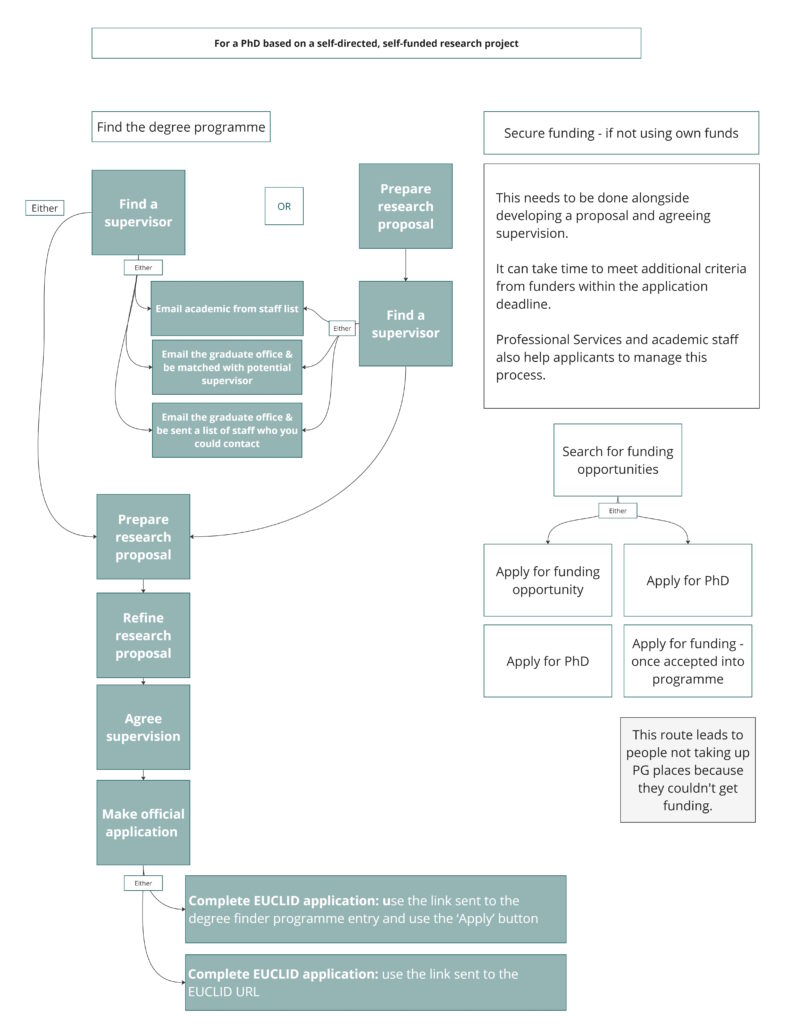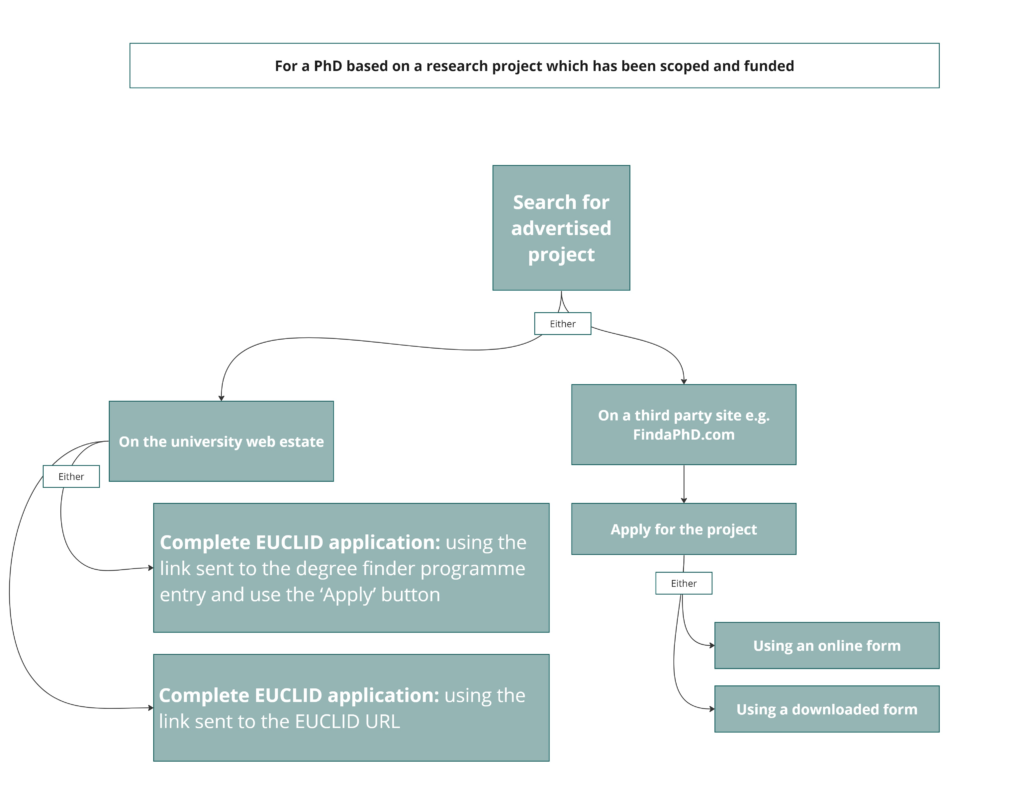Exploring the prospective Postgraduate Research application experience
Provision for prospective postgraduate research (PGR) students is largely devolved to schools, which makes it challenging to work out what is useful to publish in the centrally-managed Study section of the website. We’re undertaking discovery phase user research to better understand what students are doing and what might enhance their experience.
In this post, I outline the work I’m undertaking with support from colleagues in Student Recruitment and Admissions, The Doctoral College and our three colleges to help our team understand the student experience.
In the upcoming phase of the project to transform the University’s Degree Finders we’ll look at the provision for prospective taught postgraduate and postgraduate research (PGR) students.
We’re going to begin by looking at the provision for PGR students because we know the least about the way this group use the current Degree Finder as part of their programme selection process. We have a wealth of internal knowledge about this group, but we don’t have a deep understanding of the process from the prospective research students’ perspective. Starting here gives us an opportunity to fill this gap.
An overarching question we would like to answer is whether the Degree Finder and its list of programmes is the appropriate location for provision to this audience.
We’ve started by looking at what we know already – the wealth of internal knowledge
To inform the direction of research with prospective and current students it helps to have:
- A general understanding of the current PGR admissions processes.
- A picture of what staff currently know about this audience group.
- A general understanding of the challenges for staff.
We have started to build that internal view with a round of conversations with stakeholders: student admissions colleagues in the colleges and schools. We’ve also looked at the information available on the web estate – what’s there and how easy it is to find.
Information on the PGR application process is not clearly organised
- There is very little Information on the central web estate explaining the overall process for applying for a postgraduate research degree.
- There is information on the process across the school websites, but it is inconsistent and may also be incomplete from the students’ perspective.
- Information on the central website is linked in a circular flow, navigating can be a disjointed experience.
Schools use multiple different application processes
Because admissions are overwhelmingly managed at school level rather than college or centrally, PhD application processes are not standardised across the University. At times they can differ within a Graduate School. This poses a challenge to central information provision to clearly inform prospective students of the process they need to follow.
The multiple routes to a PhD mean that multiple processes are needed. However, there is a view from some staff that multiple variations in these processes could lead to a higher administrative overhead than necessary and there is some concern that the current state might be confusing to applicants.
Routes to finding a PhD
When conveying the process, these are the routes we know that applicants are taking. Routes 1 and 2 are the most common. Most STEM discipline PhDs follow route 1 and the majority of Arts and Humanities route 2.
- Search for an advertised, funded, project:
- Research Council funded project with Principal Investigator / Doctoral Training Centre, Centre for Doctoral Training or a Doctoral Training Partnership / Working with a Supervisor on a piece of research advertised and funded by a graduate school
- Develop your own research proposal on a theme of your own choosing & secure your own funding.
- Complete a taught programme of study which leads to a doctorate. Professionally oriented, allowing practitioners to continue to practice whilst gaining a research qualification (self-funded).
- Study while working – an industry programme which leads to a PhD.
Processes for applying
These are inextricably bound to the route students are taking to complete their PhD – whether self-directed & funded or based on a project which has already been scoped and funded.
Directed research (self-funded):
For this route, a large amount of work on selecting the candidate is completed before the online application system (commonly known as EUCLID) is completed.
- Find a supervisor:
- Find the relevant academic from a staff list and email them with a research idea – or
- Email the graduate office and be matched with an appropriate potential supervisor.
Then
- Prepare a proposal
Or
- Prepare a proposal then find a supervisor (as above)
- Refine your proposal in collaboration with potential supervisor(s)
- agree supervision
- make official application
- Use the link sent to the degree finder programme entry and use the ‘Apply’ button
- Use the link sent to the EUCLID URL
- In parallel find funding, if not using own funds:
- For some funding sources you need to have completed the application step and been accepted into a PhD programme before you can apply for funding (this leads to people not taking up posgraduate places because they couldn’t get funding).
- Even so, the process for applying for funding needs to be done alongside the process of developing a proposal and agreeing supervision because of the time needed to meet additional criteria from funders within the application deadline.
- Administration and academic staff might also help applicants to manage this process.
- Some funders allow you to apply for funding before you apply for a PhD programme.
- For some funding sources you need to have completed the application step and been accepted into a PhD programme before you can apply for funding (this leads to people not taking up posgraduate places because they couldn’t get funding).

The self-directed, self-funded prospective PhD user experience as we understand it at this stage of the project.
Funded project:
In this route, there might also be some candidate selection which takes place before the EUCLID application form is completed, depending on the nature of the project.
- Search for advertised project either on the University web estate or a third party site and apply using the in the project advertisement, this could be using:
- An online form or a downloaded form
- The degree finder ‘Apply’ button
- A link to EUCLID sent directly to the applicant

The funded project prospective PhD user experience as we understand it at this stage of the project.
The future of the Degree Finder for PGR
Because schools do direct prospective students to use the degree finder there isn’t a definitive answer to the question: should we create a separate provision for PGR programmes outside of the degree finder?
In addition, 3rd party websites embed the degree finder into their sites to enable searches for funded projects.
Different ways that schools are using the Degree Finder
- Actively directing prospective applicants to the degree finder to view programmes.
- Listing their research degrees on the school website and also link to the degree finder.
- Using the degree finder as a place to publish the ‘golden copy’ of their entry requirements.
- Using the degree finder as the official ‘apply’ step after a selection process.
There is a perception that prospective research students don’t rely on the degree finder in the same way as those applying for a taught course.
For taught courses the Degree Finder provides details of what you will study. The bespoke and individualised nature of a research degree means that is not always possible to provide the equivalent level of detail in a research degree programme entry.
However, there may be common pieces of information for a research degree programme that benefit from publication in a central location and the degree finder might be a suitable location for this.
We plan to explore this next in the project, in 1-2-1 research sessions with current and prospective research students.
Next step: learning from prospective and current PGR students
We’ve created a user journey map of what prospective research students do when finding and applying for a posgraduate research degree, based on the internal knowledge from staff.
This is only a partial picture, and we need to check that it is accurate and complete:
- Are the research degree entries in the degree finder supporting prospective students to achieve their goals?
- What are their goals? Understanding this will help us to provide the right information at the appropriate time in the process for the prospective PGR students.
Are prospective research students using the degree finder as part of their selection process? If so, how are they using it, what works and what could be improved?
We have 20 1-2-1 research sessions booked over the course of June – a cross-section representing the three colleges. We will use the insight from these sessions to supplement our internal knowledge and help us to decide on the future direction for PGR programmes in the degree finder.



